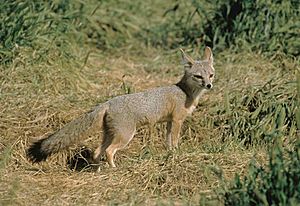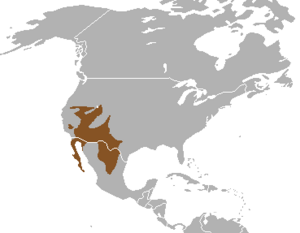Kit fox facts for kids
Quick facts for kids Kit fox |
|
|---|---|
 |
|
| Male San Joaquin kit fox | |
| Conservation status | |
| Scientific classification | |
| Genus: |
Vulpes
|
| Species: |
macrotis
|
 |
|
| Distribution of the kit fox | |
| Synonyms | |
|
|
The kit fox (Vulpes macrotis) is a small fox that lives in North America. You can find it mostly in the Southwestern United States and parts of Mexico. People sometimes call it an "American Fennec fox" because of its big ears.
Contents
Where Kit Foxes Live
Kit foxes live in many places. The farthest north they are found is in the dry areas of Oregon. To the east, they reach southwestern Colorado.
You can also find them south through Nevada, Utah, southeastern California, Arizona, and New Mexico. They even live in western Texas.
What Kit Foxes Look Like
The kit fox is one of the smallest wild dog species in North America. Only some very small pet dog breeds are tinier.
Ears and Size
Kit foxes have large ears, about 71 to 95 mm (2.8 to 3.7 in) long. These big ears help them cool down in hot weather. They also give the fox amazing hearing, much like the fennec fox.
Male kit foxes are a bit bigger than females. An average kit fox weighs between 1.6 and 2.7 kg (3.5 and 6.0 lb). Their body length is about 455 to 535 mm (17.9 to 21.1 in). Their tail adds another 250–340 mm (9.8–13.4 in) to their total length.
Fur Color
Kit foxes usually have gray fur with some rusty colors. Their tail has a black tip. Unlike the gray fox, the kit fox does not have a stripe along its tail.
Their fur color can range from yellow to gray. The fur on their back is usually darker than the rest of their body. Their belly and the inside of their ears are lighter. They also have clear dark patches around their nose.
What Kit Foxes Eat
Kit foxes are mostly active at night. This means they are nocturnal animals. Sometimes, though, they might come out of their den during the day.
They usually start hunting right after the sun sets. They mostly eat small animals. These include kangaroo rats, cottontail rabbits, black-tailed jackrabbits, and meadow voles. They also hunt hares, prairie dogs, insects, lizards, snakes, fish, and ground-dwelling birds.
Kit foxes will also eat dead animals, which is called scavenging. While they mainly eat meat, they can eat fruits if food is hard to find. They have been known to eat tomatoes and cactus fruits. Different kit fox families might hunt in the same areas. However, they usually do not hunt at the exact same time.
Where Kit Foxes Live (Habitat)
Kit foxes prefer dry places. They like desert scrub areas, chaparral, and grasslands. They can also be found in cities and farm areas.
These foxes live at heights of about 400 to 1,900 meters (1,300 to 6,200 ft) above sea level.
Kit Fox Life Cycle and Reproduction
Female kit foxes are pregnant for about 49 to 55 days. The baby foxes, called pups, stay in the den until they are about four weeks old.
They stop drinking their mother's milk after about eight weeks. Pups become independent when they are five to six months old. They are fully grown and can have their own babies at 10 months. Both parents help raise and protect their young.
Lifespan and Threats
In the wild, a kit fox usually lives for about 5.5 years. In places like zoos, they can live up to 12 years. A study in California looked at 144 kit fox pups. It found that 74% of them died within their first year.
Coyotes are the biggest danger to kit foxes. Some experts believe that three out of four kit fox deaths are caused by coyote attacks. Red foxes, feral dogs, and golden eagles also hunt the smaller kit fox.
Images for kids
-
San Joaquin kit fox family
See also
 In Spanish: Zorro kit para niños
In Spanish: Zorro kit para niños





